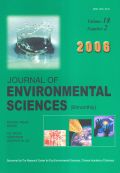Authors: Lam, K.S. | Cheng, Z.L. | Kot, S.C. | Tsang, C.W.
Article Type:
Research Article
Abstract:
An one-year of sampling aerosol program was carried out during the period of April 1995 to April 1996 at coastal region, Cape D'Aguilar, in Hong Kong. The trace element composition of aerosol particles (TSP and PM_{10} ) were measured and analyzed by using the Instrumental Neutron Activation Analysis (INAA) and Inductive Couple Plasma-Mass Spectrometry (ICP-MS) techniques. The results showed that the polluted elements such as: V, Zn, As, Pb, Cd, Sb, I, Se, Bi, with
…high enrichment factor (E. F) values, are derived from anthropogenic sources, while Sc, Al, Fe, Mn, Sm, La, Sr are less than 10 in E. F, these elements are related the crust and soil. The concentration of the trace elements are present seasonal variation i.e. summer low and winter high, whereas the V or noncrustal V(V*) present summer high and winter low, this phenomenon might be explained by local or regional oil combustion sources. Use three type of elemental ratio, e.g. La/Sm, Mn*/V* and Bi/Al indicate that both TSP and PM_{10} of La/Sm ratios are mainly related to soil and dust, Mn*/V* are probably represent fossil combustion and Bi/Al are possibly associated with refuse incineration, ferromanganese alloys and aluminum production. The varimax rotation factor analysis for trace elements was performed. By means of the absolute principal component analysis (APCA) and multiple regression, the contribution of trace elements to possible sources and overall means of trace elements were estimated. The results showed that the present station is impacted by the anthropogenic species, although the quantities are different during the summertime and wintertime.
Show more
Keywords: TSP, PM_{10}, trace elements, enhancement factor, element ratios, seasonal variation, factor analysis
Citation: Journal of Environmental Sciences,
vol. 16, no. 2, pp. 212-221, 2004
Price: EUR 27.50





